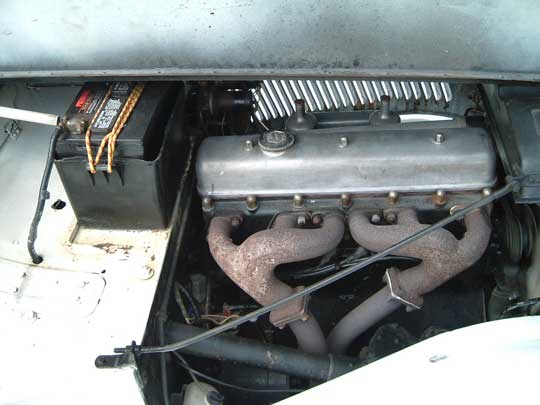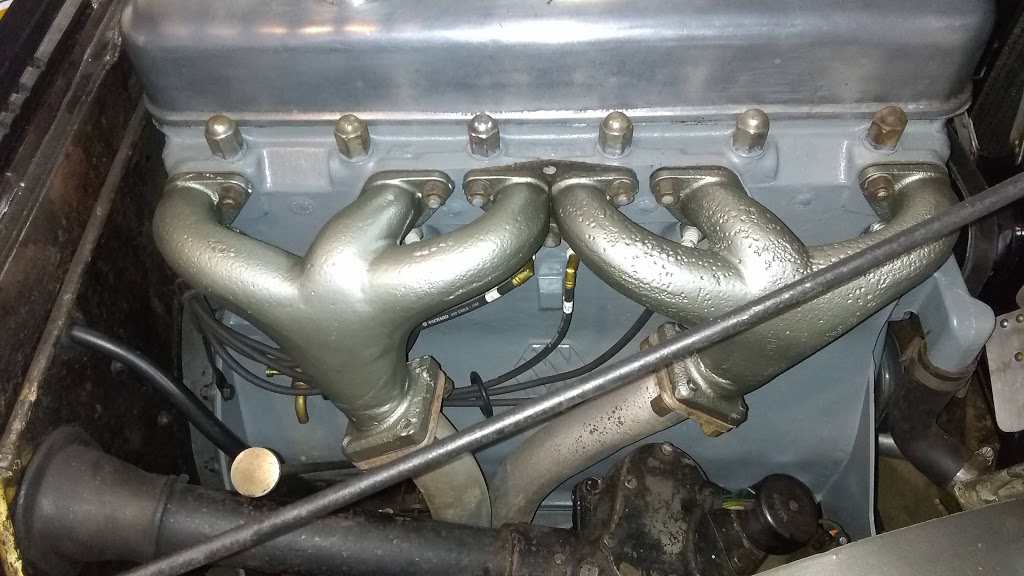Well, the engine and gearbox are out of the '38 saloon. Main reason is to investigate and repair the noisy gearbox, a good winter indoor project. I suspect lay shaft bushings, so I’ll open a separate topic when I have something to report there.
Secondary is to deal with that pale yellow and pale green paint on the engine. It really bugs me.
It was a nice sunny day today, about the last we’ll get here this year, so I rolled the engine out into the driveway and began the paint stripping.
Under the yellow and green I was expecting to find black.
Nope, I found medium grey, about the same as machinery grey or electrical junction boxes, or about a match for my Atlas drill press.
Block, head and water pump are grey.
No grey on the front timing chain cover nor the side tappet cover, front mounting steel plate nor rear steel plate, but no black either.
So what do you all think?
Is that grey the original color of the block, pump and head?
Hi Rob, Just having a bit of fun here, but 1938 then this would be a Standard engine? Maybe you have ended up with a Ferguson engine here? Little Grey Fergie 
And then… it became the TR-2 engine…![]()
Under some bright blue hand painted colour I took off my 1948 MK IV engine was definitely an original grey green colour (even into the spark plug recesses and behind attached parts) on the main case, with all the covers, brackets, etc in black. Perhaps the Standard engine factory did not use a standard colour but what was in the storeroom at the time?
Hi Rob,
I’ve attached seven photos of SS Jaguar engines all from different cars. Two are green and the rest are black.
Peter

That 6-into-1 manifold is interesting: I’d never seen that style, before.
That’s what was used on the coachbuilt cars. When Lyons converted to all steel bodies the cars got heavier so instead of the single pipe exhaust system a twin pipe system was used to extract a couple more horse power.
Peter
I like the Ferguson connection. We have a lot of those Ford 9Ns here but I never knew they were connected to Ferguson. Better than that, I could go for the David Brown connection. DB-SS 
Interesting that David and Peter mention green and grey/green. Mine is sort of on the border line of grey and green, like yesterday in sunlight it looked gray but today is cloudy so maybe it could be called green. Or old mold. 
More stripping today reveals a few flecks of black under the gray on the timing cover and tappet cover, and red under the grey on the water pump. No doubt made the pump turn faster.
Maybe those components were painted by the component suppliers before they got to Standard?
Or replacements from a black engine? We’ll never know I guess.
Whoever did the pale green over the grey was certainly thorough, got just about everywhere. The pale yellow over the pale green was…less so. Somebody even did green over the blue on the pressure plate.
Also discovered grey on a couple of chromed head nuts. Was it painted after it was more or less mostly assembled at Standard?
I remembered this from an article in Jag World about 30973, sent to me by Peter awhile back. Its a 3.5 where mine is a 2.5 but I suppose Standard used the same paint.
Moldy green is out and I don’t really like machinery grey. It would show all the oil leaks.

Well, I have until next spring to decide whether to match it or go black.
I can tell you black shows the oil leaks on my engine, but surely less obvious than machinery grey.
That’s certainly true but I have never seen figures to show the improvement.
I changed my 36 engine to twin headers without noticeable improvement.
Oddly the single, finned manifold with either 2 or 3 bolt engine pipe flange is worth more, financially , than the twins.
I confess that I haven’t seen any figures either but it’s difficult to think of Lyons doubling the cost of the exhaust system for no reason. Quoting from “The Motor” 12th July 1938 “The manifolding of these engines has been the subject of particular study on both the inlet and exhaust side. The exhaust manifolds, tail pipes and silencers are duplicated and it has been found by careful bench testing that this scheme very definitely gives not only an increase in horse-power, but also cooler exhaust valves.”
Paul Skilleter writes: “The changes were more than enough to compensate for an extra couple of hundredweight, and added several mph to the top speed.”
He also quotes numbers:
1936, 102 bhp @ 4600 rpm c.r. 6.4:1
1937, 104 bhp @ 4500 rpm c.r. 6.8:1
1938-40, 105 bhp @ 4600 rpm (approx.) c.r. 7.6:1
MkV, 102 bhp @ 4600 rpm. c.r. 7.3:1
Peter
I take it Peter is quoting 2-1/2 Litre figures without decompression plate.
BTW with Mark V it was back to single exhaust and a really long muffler.
That single header would have been convenient for me. There is barely enough room in there for two down pipes.
Mine is one of the first all-steel cars and is continually showing new evidences that they were still working out how to get the pieces to fit together.
At the speeds these engines operate, with their relatively-low state of tune, I’m not convinced the admittedly prettier “ram’s horn” manifolds could make all that much difference.
On my stock-engine Datsun 1200 ITC racer, I went back to the clunky-looking stock cast iron manifold, because although the tube headers got me 5 hp more at 7000 rpm, I lost ~15 ft-lbs of torque, lower down.
On short tracks–and street conditions–torque is king.
Hi Paul,
I tend to agree with you. Another change between the SS / MkIV and the MkV was the cam timing. I have tried both and the SS and MkIV do go round the clock slightly faster at the top end but they lose out relative to the MkV at the revs in most frequent use so I’m using the MkV shaft in my SS.
I simulated the cam timing difference using the Lotus Engine Modelling software here.
Peter
Yikes: that level of close proximity radiant heat can’t be good for the steering box?
Im sure my '40 engine was a light green/grey. I should have taken more attention but got talked into painting it black. Wish I hadn’t
About the same colour as the seat frame of an XK120
Looking at my Mark V engine today, I realized that, while grey shows the oil leaks, black shows all the dust. So I guess I’ll go with grey.












